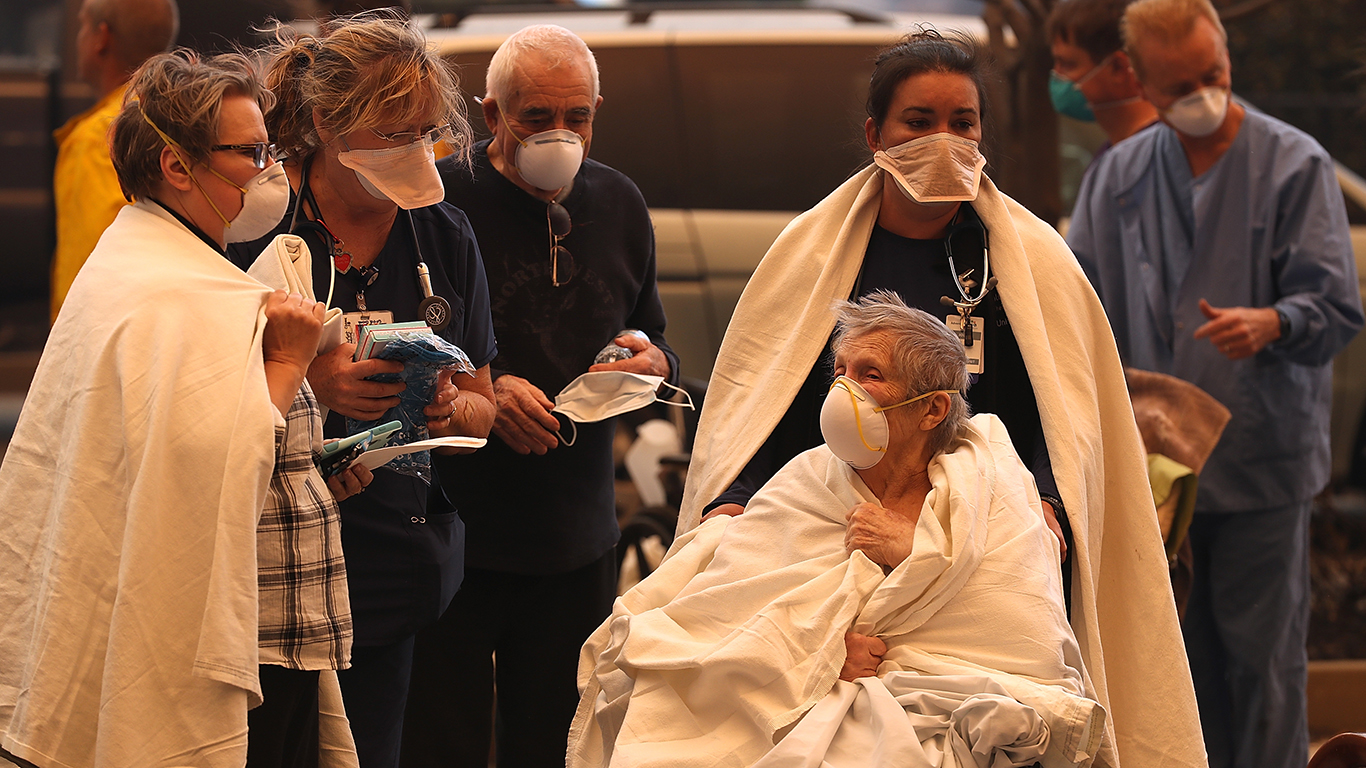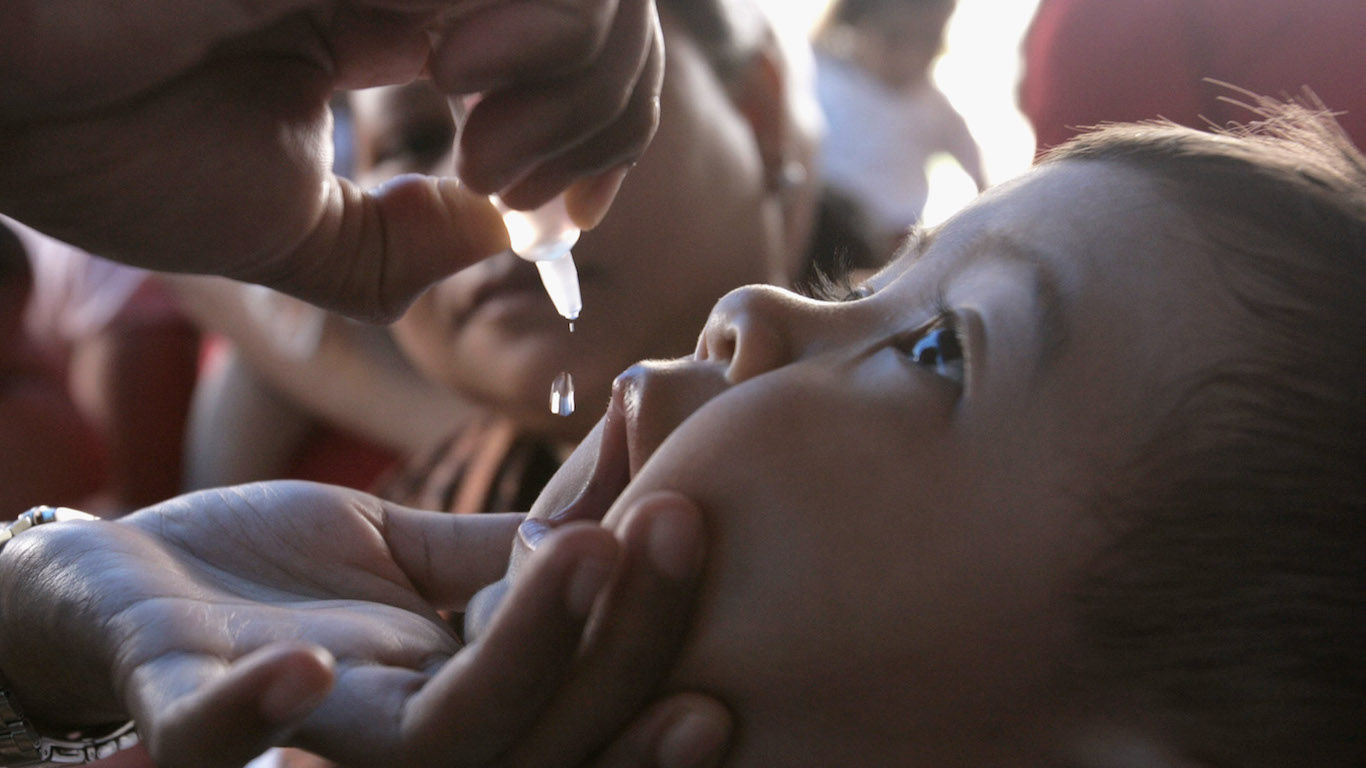

The world before vaccines was vastly different than today. Children — and adults — regularly contracted serious infectious diseases that up until recently have been but a distant memory. The paralytic disease polio has all but been eradicated in the United States by the 1980s, as were several other vaccine-preventable diseases. In fact, one of the most terrible diseases in history – smallpox – no longer exists outside the laboratory. Unfortunately, some of these diseases are now making a comeback due to lower immunization rates.
Several infection-preventing vaccines are widely available in the United States, including for some of the most aggressive contagions that are particularly harmful to children, the elderly, and people with auto-immune deficiencies.
In recent years, public health efforts to vaccinate children and protect them from such diseases as measles, mumps, and whooping cough have been undermined by the recent rise of the anti-vaccine movement and the considerable pervasive misinformation about vaccines. This is the one almost sure sign you have measles.
Compared to other developed countries with the highest measles vaccination rates, the United States is not near the top and could clearly do better. On the other hand, these are the 25 countries where measles is a serious problem.
The effects of the spread of vaccine misinformation has been felt across the United States. The Centers for Disease Control and Prevention has identified 1,182 individual cases of measles so far this year, the highest number since the virus had been declared eradicated from the country in 2000. The reappearance of measles since then is particularly disturbing — it is among a handful of infections that doctors fear most, along with viral pneumonia, meningitis, and influenza.
In January, Washington Gov. Jay Inslee declared a public health emergency after health officials identified an outbreak of measles. Most of the infected individuals were under the age of 10 and none had received the standard MMR (measles, mumps, and rubella) vaccination that is typically administered twice within the first 15 months from birth. This was not an isolated incident. The CDC says measles outbreaks have occurred in 30 states so far this year.
Most U.S. states require childhood vaccinations before children can enter the public school system, but they also allow exemptions for parents based on religious or philosophical beliefs. New York – where more than 75% of this year’s measles cases are linked to – became the fifth state along with California, Maine, West Virginia, and Mississippi, in eliminating these belief-based exemptions.
Click here to see the states with the highest and lowest vaccination rates
To identify the states with the highest and lowest vaccination rates, 24/7 Wall St. reviewed vaccine data from the Centers for Disease Control and Prevention (CDC). The data included the percentage of vaccination coverage for the combined 7-vaccine series among children aged 19-35 months in each state in 2016. Vaccination rates for selected diseases by race and poverty level came from the CDC for 2017. U.S. adolescent vaccination coverage for the years 2008-2016 and Influenza vaccination rates among adults in the United States also came from the CDC and are for 2017. Social and economic factors, including health insurance coverage, household income, and educational attainment came from the U.S. Census Bureau’s 2017 1-year American Community Survey (ACS). Annual state unemployment data came from the Bureau of Labor Statistics (BLS) and is for 2018.

1. Massachusetts
> Child vaccination rate: 85.3%
> Population under 5 years: 360,336 (5.3% — 6th lowest)
> Population with no health insurance: 2.8% (the lowest)
> Total exemptions (2015-2016): 976
[in-text-ad]

2. Nebraska
> Child vaccination rate: 80.6%
> Population under 5 years: 131,679 (6.9% — 6th highest)
> Population with no health insurance: 8.3% (23rd highest)
> Total exemptions (2015-2016): 608

3. Wisconsin
> Child vaccination rate: 79.4%
> Population under 5 years: 333,985 (5.8% — 14th lowest)
> Population with no health insurance: 5.4% (10th lowest)
> Total exemptions (2015-2016): 2,295

4. Delaware
> Child vaccination rate: 78.1%
> Population under 5 years: 54,907 (5.7% — 11th lowest)
> Population with no health insurance: 5.4% (10th lowest)
> Total exemptions (2015-2016): 136
[in-text-ad-2]

5. New Hampshire
> Child vaccination rate: 78.0%
> Population under 5 years: 63,523 (4.7% — the lowest)
> Population with no health insurance: 5.8% (14th lowest)
> Total exemptions (2015-2016): 309

6. North Carolina
> Child vaccination rate: 77.8%
> Population under 5 years: 601,181 (5.9% — 18th lowest)
> Population with no health insurance: 10.7% (10th highest)
> Total exemptions (2015-2016): 1,382
[in-text-ad]

7. Alabama
> Child vaccination rate: 77.3%
> Population under 5 years: 288,897 (5.9% — 19th lowest)
> Population with no health insurance: 9.4% (14th highest)
> Total exemptions (2015-2016): 478

8. Georgia
> Child vaccination rate: 77.3%
> Population under 5 years: 655,223 (6.3% — 15th highest)
> Population with no health insurance: 13.4% (4th highest)
> Total exemptions (2015-2016): 2,460

9. Vermont
> Child vaccination rate: 76.8%
> Population under 5 years: 30,096 (4.8% — 3rd lowest)
> Population with no health insurance: 4.6% (5th lowest)
> Total exemptions (2015-2016): 361
[in-text-ad-2]

10. Colorado
> Child vaccination rate: 76.4%
> Population under 5 years: 332,593 (5.9% — 21st lowest)
> Population with no health insurance: 7.5% (23rd lowest)
> Total exemptions (2015-2016): 2,963

11. Kansas
> Child vaccination rate: 76.4%
> Population under 5 years: 193,049 (6.6% — 9th highest)
> Population with no health insurance: 8.7% (20th highest)
> Total exemptions (2015-2016): 651
[in-text-ad]

12. Connecticut
> Child vaccination rate: 75.7%
> Population under 5 years: 182,194 (5.1% — 4th lowest)
> Population with no health insurance: 5.5% (12th lowest)
> Total exemptions (2015-2016): 799

13. Washington
> Child vaccination rate: 75.7%
> Population under 5 years: 455,015 (6.1% — 21st highest)
> Population with no health insurance: 6.1% (18th lowest)
> Total exemptions (2015-2016): 3,878

14. Rhode Island
> Child vaccination rate: 75.5%
> Population under 5 years: 55,019 (5.2% — 5th lowest)
> Population with no health insurance: 4.6% (5th lowest)
> Total exemptions (2015-2016): 126
[in-text-ad-2]

15. Hawaii
> Child vaccination rate: 75.1%
> Population under 5 years: 89,573 (6.3% — 16th highest)
> Population with no health insurance: 3.8% (2nd lowest)
> Total exemptions (2015-2016): 496

16. Kentucky
> Child vaccination rate: 74.5%
> Population under 5 years: 276,356 (6.2% — 19th highest)
> Population with no health insurance: 5.4% (10th lowest)
> Total exemptions (2015-2016): 510
[in-text-ad]

17. Maryland
> Child vaccination rate: 74.4%
> Population under 5 years: 363,313 (6.0% — 24th lowest)
> Population with no health insurance: 6.1% (18th lowest)
> Total exemptions (2015-2016): 949

18. Idaho
> Child vaccination rate: 73.9%
> Population under 5 years: 116,226 (6.8% — 7th highest)
> Population with no health insurance: 10.1% (11th highest)
> Total exemptions (2015-2016): 1,389

19. Minnesota
> Child vaccination rate: 73.8%
> Population under 5 years: 353,860 (6.3% — 12th highest)
> Population with no health insurance: 4.4% (3rd lowest)
> Total exemptions (2015-2016): N/A
[in-text-ad-2]

20. Pennsylvania
> Child vaccination rate: 73.7%
> Population under 5 years: 705,018 (5.5% — 9th lowest)
> Population with no health insurance: 5.5% (12th lowest)
> Total exemptions (2015-2016): 3,132

21. Iowa
> Child vaccination rate: 73.5%
> Population under 5 years: 198,623 (6.3% — 13th highest)
> Population with no health insurance: 4.7% (6th lowest)
> Total exemptions (2015-2016): 754
[in-text-ad]

22. New York
> Child vaccination rate: 72.3%
> Population under 5 years: 1,157,597 (5.8% — 16th lowest)
> Population with no health insurance: 5.7% (13th lowest)
> Total exemptions (2015-2016): 2,052

23. Utah
> Child vaccination rate: 72.2%
> Population under 5 years: 253,089 (8.2% — the highest)
> Population with no health insurance: 9.2% (15th highest)
> Total exemptions (2015-2016): 2,302

24. Nevada
> Child vaccination rate: 71.9%
> Population under 5 years: 184,055 (6.1% — 22nd highest)
> Population with no health insurance: 11.2% (8th highest)
> Total exemptions (2015-2016): 732
[in-text-ad-2]

25. Illinois
> Child vaccination rate: 71.5%
> Population under 5 years: 767,348 (6.0% — 23rd lowest)
> Population with no health insurance: 6.8% (20th lowest)
> Total exemptions (2015-2016): N/A

26. Maine
> Child vaccination rate: 70.6%
> Population under 5 years: 64,390 (4.8% — 2nd lowest)
> Population with no health insurance: 8.1% (25th highest)
> Total exemptions (2015-2016): 612
[in-text-ad]

27. Mississippi
> Child vaccination rate: 70.4%
> Population under 5 years: 182,467 (6.1% — 24th highest)
> Population with no health insurance: 12.0% (7th highest)
> Total exemptions (2015-2016): 18

28. South Dakota
> Child vaccination rate: 70.4%
> Population under 5 years: 60,460 (7.0% — 5th highest)
> Population with no health insurance: 9.1% (16th highest)
> Total exemptions (2015-2016): 197

29. Michigan
> Child vaccination rate: 70.2%
> Population under 5 years: 572,370 (5.7% — 12th lowest)
> Population with no health insurance: 5.2% (7th lowest)
> Total exemptions (2015-2016): 4,203
[in-text-ad-2]

30. New Jersey
> Child vaccination rate: 70.2%
> Population under 5 years: 520,361 (5.8% — 15th lowest)
> Population with no health insurance: 7.7% (24th lowest)
> Total exemptions (2015-2016): 1,938

31. Arizona
> Child vaccination rate: 69.9%
> Population under 5 years: 435,041 (6.2% — 20th highest)
> Population with no health insurance: 10.1% (11th highest)
> Total exemptions (2015-2016): 3,921
[in-text-ad]

32. South Carolina
> Child vaccination rate: 69.7%
> Population under 5 years: 289,539 (5.8% — 13th lowest)
> Population with no health insurance: 11.0% (9th highest)
> Total exemptions (2015-2016): 960

33. Texas
> Child vaccination rate: 69.5%
> Population under 5 years: 2,020,164 (7.1% — 3rd highest)
> Population with no health insurance: 17.3% (the highest)
> Total exemptions (2015-2016): 6,170

34. Alaska
> Child vaccination rate: 68.8%
> Population under 5 years: 52,919 (7.2% — 2nd highest)
> Population with no health insurance: 13.7% (3rd highest)
> Total exemptions (2015-2016): 524
[in-text-ad-2]

35. Indiana
> Child vaccination rate: 68.8%
> Population under 5 years: 419,552 (6.3% — 14th highest)
> Population with no health insurance: 8.2% (24th highest)
> Total exemptions (2015-2016): 1,035

36. New Mexico
> Child vaccination rate: 68.5%
> Population under 5 years: 126,427 (6.1% — 25th highest)
> Population with no health insurance: 9.1% (16th highest)
> Total exemptions (2015-2016): 365
[in-text-ad]

37. North Dakota
> Child vaccination rate: 68.2%
> Population under 5 years: 52,802 (7.0% — 4th highest)
> Population with no health insurance: 7.5% (23rd lowest)
> Total exemptions (2015-2016): 329

38. Ohio
> Child vaccination rate: 68.0%
> Population under 5 years: 695,130 (6.0% — 22nd lowest)
> Population with no health insurance: 6.0% (15th lowest)
> Total exemptions (2015-2016): 3,255

39. Arkansas
> Child vaccination rate: 67.8%
> Population under 5 years: 186,640 (6.2% — 18th highest)
> Population with no health insurance: 7.9% (25th lowest)
> Total exemptions (2015-2016): 512
[in-text-ad-2]

40. Tennessee
> Child vaccination rate: 67.4%
> Population under 5 years: 405,128 (6.0% — 25th lowest)
> Population with no health insurance: 9.5% (13th highest)
> Total exemptions (2015-2016): 850

41. Florida
> Child vaccination rate: 67.1%
> Population under 5 years: 1,129,322 (5.4% — 7th lowest)
> Population with no health insurance: 12.9% (5th highest)
> Total exemptions (2015-2016): 4,925
[in-text-ad]

42. Oklahoma
> Child vaccination rate: 67.0%
> Population under 5 years: 262,561 (6.7% — 8th highest)
> Population with no health insurance: 14.2% (2nd highest)
> Total exemptions (2015-2016): 895

43. Missouri
> Child vaccination rate: 66.9%
> Population under 5 years: 374,001 (6.1% — 23rd highest)
> Population with no health insurance: 9.1% (16th highest)
> Total exemptions (2015-2016): N/A

44. Louisiana
> Child vaccination rate: 66.8%
> Population under 5 years: 306,213 (6.5% — 11th highest)
> Population with no health insurance: 8.4% (22nd highest)
> Total exemptions (2015-2016): 445
[in-text-ad-2]

45. Virginia
> Child vaccination rate: 65.9%
> Population under 5 years: 501,972 (5.9% — 20th lowest)
> Population with no health insurance: 8.8% (19th highest)
> Total exemptions (2015-2016): 1,155

46. California
> Child vaccination rate: 65.3%
> Population under 5 years: 2,460,425 (6.2% — 17th highest)
> Population with no health insurance: 7.2% (21st lowest)
> Total exemptions (2015-2016): 15,000
[in-text-ad]

47. West Virginia
> Child vaccination rate: 64.7%
> Population under 5 years: 97,887 (5.4% — 8th lowest)
> Population with no health insurance: 6.1% (18th lowest)
> Total exemptions (2015-2016): 35

48. Montana
> Child vaccination rate: 63.6%
> Population under 5 years: 61,405 (5.8% — 17th lowest)
> Population with no health insurance: 8.5% (21st highest)
> Total exemptions (2015-2016): 439

49. Wyoming
> Child vaccination rate: 62.8%
> Population under 5 years: 37,910 (6.5% — 10th highest)
> Population with no health insurance: 12.3% (6th highest)
> Total exemptions (2015-2016): 209
[in-text-ad-2]

50. Oregon
> Child vaccination rate: 58.1%
> Population under 5 years: 232,253 (5.6% — 10th lowest)
> Population with no health insurance: 6.8% (20th lowest)
> Total exemptions (2015-2016): 2,871
Take This Retirement Quiz To Get Matched With A Financial Advisor (Sponsored)
Take the quiz below to get matched with a financial advisor today.
Each advisor has been vetted by SmartAsset and is held to a fiduciary standard to act in your best interests.
Here’s how it works:
1. Answer SmartAsset advisor match quiz
2. Review your pre-screened matches at your leisure. Check out the
advisors’ profiles.
3. Speak with advisors at no cost to you. Have an introductory call on the phone or introduction in person and choose whom to work with in the future
Take the retirement quiz right here.
Thank you for reading! Have some feedback for us?
Contact the 24/7 Wall St. editorial team.
 24/7 Wall St.
24/7 Wall St. 24/7 Wall St.
24/7 Wall St. 24/7 Wall St.
24/7 Wall St. 24/7 Wall St.
24/7 Wall St. 24/7 Wall St.
24/7 Wall St. 24/7 Wall St.
24/7 Wall St.
